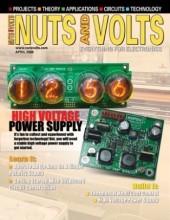Nuts and Volts Magazine
Features
I have been interested in photography since I was a teenager and I remember the early days of color slide processing. Things have definitely come a long way since then. While the costs of the digital cameras have dropped, the quality of the photos produced has increased. In this series, I will show you how to create some cool electronic projects that will allow you to control your camera in ways you may find very useful. Along with these projects, I will also show you how to use...
Understanding And Designing With The Ever-Useful CMOS Timer
No serial port on your PC? No problem! To add a serial port, attach a USB/serial adapter to a USB port. This article focuses on the PC side of serial port communications. I’ll show how to use Visual Basic .NET to access serial ports, including USB virtual serial ports.
Question: How does one connect a single polarity voltage source to an op-amp that wants to see both a positive and a negative voltage supply? Answer: Read On!
Here is an interesting experiment — try to turn off everything electrical in your home. Turn off the lights, heater, refrigerator, AC, TV, stereo, everything – then go out and look at your power meter.
Projects
It’s fun to collect and experiment with forgotten technology!
Build this PIC-based thermostat and heating/cooling control box and take control of your household environment.
Columns
TechKnowledgey
by Jeff Eckert
Techknowledgey 2008
Events, Advances, and News
Personal Robotics
by Vern Graner
A Preview Of The New Digiencabulator
Many of us have read about (and drooled over!) some of the amazing gadgets the major names in robotics development have displayed over the last couple of decades. Just watching the DARPA Grand Challenge has shown us high-end “LADAR” laser range finders, massive multi-processor computers, and custom-written fuzzy logic based AI computer vision systems...
Q&A
by Russell Kincaid
Q&A
In this column, I answer questions about all aspects of electronics, including computer hardware, software, circuits, electronic theory, troubleshooting, and anything else of interest to the hobbyist.
The Design Cycle
by Fred Eady
Welcome To the land of CPLD
If you’ve been following Design Cycle, you know that we do lots of neat stuff with Microchip’s family of PIC microcontrollers. When a new variant of the PIC goes public — such as the PIC32 — we most always need to ride the learning curve to figure out what we can do with the new part. That’s what Design Cycle is all about. And, yep. I’m setting you up for something new. And, nope. This time it’s not a PIC...
Open Communication
by Louis E. Frenzel
Wi-Fi Makes Internet Radio Wireless
One more option for the radio enthusiast: You just don’t know how lucky you are. Just think of all the options you have in listening to radio. There are the old standbys like AM and FM stations that most of us still listen to mainly in the car. There are thousands of stations nationwide and dozens in your local area. Then there is the newer HD radio that puts digital broadcasts into the AM and FM bands for higher fidelity, better noise, and fading immunity, and more station choices...
PICAXE Primer
by Ron Hackett
Getting Started With Stripboard Circuit Construction
If you have been reading the PICAXE Primer or any of my articles in Nuts & Volts and SERVO Magazine, you know by now that I am very partial to working with breadboard circuits. I think they are by far the fastest and most flexible approach to building and debugging a PICAXE-based circuit, or any small circuit for that matter. However, sooner or later you may want to construct a circuit that is more reliable and “permanent” than a breadboard circuit...
Departments

